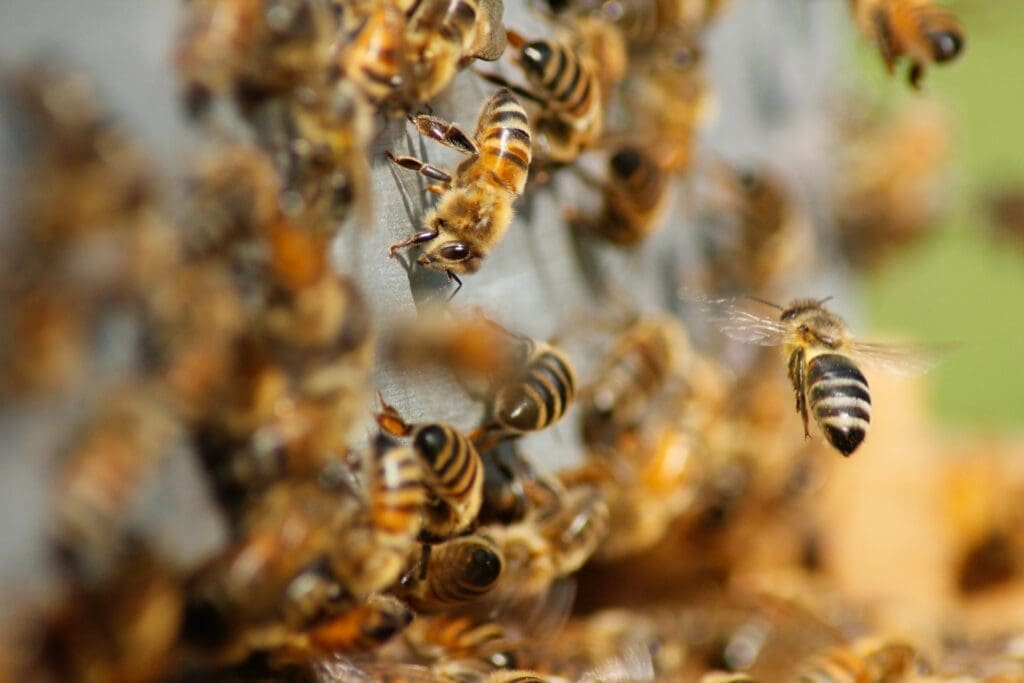
Apis mellifica
Latin name: Apis mellifica
Short name: Apis
Common name: Honeybee | Domestic bee | European honeybee | Apis | Bee venom
Primary miasm: Psoric Secondary miasm(s): Sycotic
Kingdom: Animals
Family: Apidae
- Symptomatology
- Remedy Information
- Differentiation & Application
Apis mellifica is prepared from the whole live honeybee, including its venom, organs, and fluids, triturated and potentised in accordance with homeopathic pharmacy standards. The venom contains multiple biologically active compounds, including melittin, hyaluronidase, and histamine-like substances, which provoke an intense local and systemic reaction in sensitive individuals. Its action centres around swelling, inflammation, burning, and stinging sensations.
In conventional medicine, purified bee venom is sometimes used in desensitisation therapy for bee sting allergies. In apitherapy and traditional medicine, bee venom is occasionally employed for conditions like arthritis or nerve pain. Honey, propolis, wax, and royal jelly from Apis mellifera are widely used in nutrition and skincare.
First proved by Dr. Drury and Dr. Marcy in the mid-1800s, with Hering systematising the proving and publishing results. The proving was based on actual bee stings and ingestion of triturated whole bees.
- Skin and cellular tissue (oedema, urticaria)
- Mucous membranes
- Kidneys and urinary system
- Throat and larynx
- Serous membranes (especially pleura, meninges)
- Right ovary
- Pericardium and synovial linings
- Mind (especially irritability, jealousy, hysteria)
Cold applications; open air; uncovering; motion; washing in cold water.
Heat; touch; pressure; afternoon (especially 3–5 PM); suppressed eruptions; sleeping in a warm room; menstruation; right side.
- Cantharis: Burning urine, but with more tenesmus and rawness.
- Belladonna: Sudden and red, but more throbbing, congestive heat, and delirium.
- Lachesis: Also right-sided and worse for heat, but more congested, loquacious, and purple.
- Urtica urens: Urticaria with more itching and less oedema.
- Sulphur: Burning, red, itchy skin—more chronic, worse for heat in general.
- Complementary: Natrum mur., Apis follows Belladonna
- Antidotes: Camphor, Ledum, Vinegar
- Inimical: Rhustox (some authors)
- Follows well: Belladonna, Cantharis
- Precedes well: Sulphur, Arsenicum album
The Apis patient reacts instinctively—hot, swollen, stinging, and overreactive. It is a remedy of fluid imbalance, inflammatory sensitivity, and defensiveness, both physical and emotional. Their wounds are red, raised, and painful—just like their hearts. The core state is one of irritated vulnerability, with hyperalertness, fear, and emotional or physical oedema. They defend against violation and suppress emotion until it explodes—like the sting of the bee.
Indicated in acute oedematous states, nephritis, cystitis, meningitis, hives, anaphylaxis, and ovarian inflammation. Always think Apis when you see sudden swelling, burning, and worse from heat. Start with 30C or 200C in acute cases. In constitutional states, 1M or LM may be used cautiously, especially in hypersensitive constitutions.
Mind
- MIND – Jealousy
- MIND – Shrieking with pain
- MIND – Ailments from suppressed eruptions
Urinary Organs
- URINE – Scanty
- URINE – Albuminous
- URINE – Burning during micturition
Female Genitalia
- OVARIES – Inflammation, right
- OVARIES – Pain, stinging, burning
Skin
- SKIN – Urticaria
- SKIN – Oedema
- SKIN – Erysipelas
Generalities
- GENERALITIES – Heat, aggravates
- GENERALITIES – Worse 3–5 PM
- GENERALITIES – Touch, aggravates
- GENERALITIES – Dropsy, serous effusions
Constantine Hering, Guiding Symptoms of Our Materia Medica
John Henry Clarke, A Dictionary of Practical Materia Medica
James Tyler Kent, Lectures on Homoeopathic Materia Medica
William Boericke, Pocket Manual of Materia Medica
Henry C. Allen, Keynotes and Characteristics
Dr. C. Wesselhoeft & Dr. Marcy, early provings
